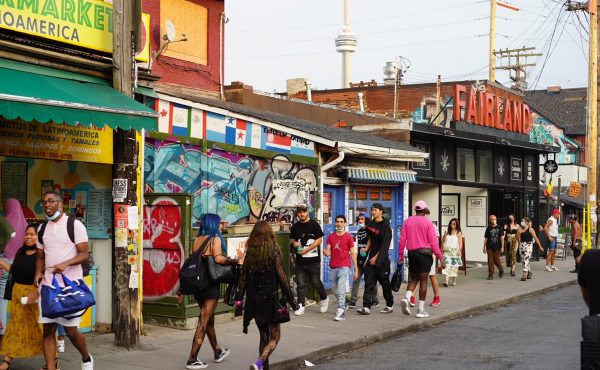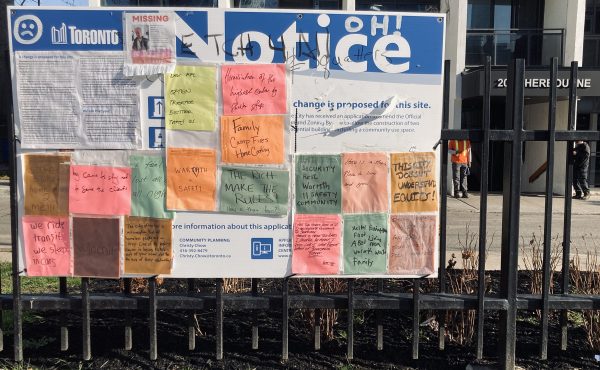This is a cross-post from Carly Dunster Law. Ms. Dunster is a Spacing contributor who works with food entrepreneurs, food initiatives, and acts as an advocate for small food producers.
![]()
Revitalization. Beautification. Rejuvenation. All terms with positive connotations, that conjure up images of something better for city-goers… a more aesthetically pleasing, vibrant streetscape, a historical building restored to its prime, more green space. But sometimes the drive for beautification can have significant negative impacts – collateral damage, if you will.
In the case of the Union Station revitalization, some of those negative impacts come in the form of taking away the livelihoods of six street food vendors. The design for Union Station, at this point, does not contemplate a designated spot for any of these individuals, some of whom have been making a living selling food to hungry Torontonians for as long as 26 years. A compromise was reached with the Toronto East York Community Council recently, allowing the affected vendors to seek out alternative spots within downtown wards. The problem is that the By-Law governing street food vending in Toronto (Chapter 315) sets out quite stringent requirements necessary for a viable vending location, meaning there aren’t a whole lot of places that meet the necessary criteria.
There has been significant media coverage in the past year or so about how Toronto is up to its ears in red tape when it comes to street food vendors. It’s true. At the same time, there’s been an upswing of interest in food trucks, pop-up restaurants, and underground markets, all part of an increasingly dynamic, increasingly creative food scene in Toronto. For some reason though, hot dog vendors often get left out of that conversation.
First, it was A La Cart, a program that, while filled with good intentions, felt like a blow to the city’s hot dog vendors, who had been fighting to serve more diverse foods for years. Because here’s how it worked: one could apply to become a part of the A La Cart program, but you’d have to give up your existing vendor’s permit to do so. And we have something called a moratorium in place in three of the downtown wards. It dictates that no new vending permits may be issued in Wards 20, 27, and 28. Really, the establishment of the moratorium, established in 2002, was probably the first blow – there used to be over 300 vendors, now there are approximately 130 operating in Toronto. The presence of the moratorium meant that if you gave up your license, you weren’t getting it back. Not such an enticing proposition.
A lot of experienced vendors knew from the start that A La Cart would fail. There was the poor cart design, the oversight of the program being handed to Toronto Public Health (instead of sticking with Municipal Licensing), and the requirement that all carts be identical, effectively quashing the expressions of culture and individuality that make street food so awesome. And fail it did. Though there are a few remaining A La Cart carts, the project itself was discontinued.
Then there was the Bloor Street revitalization project, which dislocated eight hot dog vendors in early 2011. Three alternative locations were proposed, but the spots were not comparable to the high-traffic Bloor Street. One vendor stated that he couldn’t even make enough money to pay his permit fee, let alone make a profit or help support his family. He was ultimately granted a permit in a high-traffic downtown location, but only after about a year of wrangling, and more importantly, a year of not being able to make a living.
So, here we are at Union Station. The plan is not yet finalized, and there is some room for hope. But it’s hard not to feel discouraged when reviewing what’s been proposed thus far. There proposed plan has room for only two street food vendor locations, and unconfirmed reports have indicated that those two locations are meant to go to franchises of chain restaurants that will be located within the Station.
Infrastructure investment, like that going toward the revitalization of Union Station, is meant to stimulate growth and create jobs, not unilaterally remove jobs from the hands of street vendors who have worked decades to establish themselves. An important objective of the revitalization project is to create an urban design framework that fosters a pedestrian culture. Street food vending is a part of that.
As Jane Jacobs stated, “…lowly, unpurposeful and random as they may appear, sidewalk contacts are the small change from which a city’s wealth of public life may grow”. The affected street food vendors had been revitalizing Union Station the whole time they’d been there – and we’d be wise to let them continue to do so.
photo by Wylie Poon






11 comments
I’m all for innovative ways to broaden our food sources, and street foods have a part to play there.
But it seems a little strange that Spacing, given its mandate, would so fervently support street vendors who – by their very nature – encroach on public space, while giving little to nothing back to the community by way of taxes (unlike restaurants which *do* pay municipal taxes).
Hot dog vendors do not encroach on public space, they help make it dynamic. They interact with people and serve a purpose, unlike say the Info Pillars.
To say that food vendors do not pay taxes is silly — they pay City fees coming out the wazoo and they also rent the 10 sq feet of space they use. What they give back, outside of taxes, is a service that is needed at the street level and add a dynamic to the public realm that is lacking in so many places in this city.
Spacing would love to see a variety of street food on our sidewalks, but that’s another policy debate to have. But the revitalization plans at Union Station that ignore street vendors are the opposite of what we believe in, and much more so than any minor ‘encroachment’ they have on our sidewalks.
Ah, street food, the finest example of Toronto’s world class redtaping, the sheer beauty of idiotic bureaucracy.
It’s worth pointing out that Front St. in front of Union Station is something of a retail desert – it could really use some animation through street vendors. And there are tons of people moving through it who might want something to eat.
The FAQs about the new design spend a lot longer trying to justify the vendor issue than on any other issue. Possibly a case of showing the weakness of the case by protesting too much.
I hadn’t heard that the two existing vendor spots might go to chain restaurants – from bad to worse.
One of the really good things about Nathan Phillips Square is the food trucks along Queen. They add food, aroma and colour and a lot of friendly activity. Even the seagulls that gather there are fun to watch.
This is a bit of a toss-up really, while I don’t like to see street food vendors put out of work, it begs the question, should all city development and beautification projects be shelved, because street food vendors might not have the space they used to occupy. Part of the problem is that the city has restrictions on where food vendors can ply their trade, rather then rules on where food vendors can ply their trade. There is a subtitle difference that is huge,
Rules for where food vendors can be located would be something like:
Can not block a traffic (including bicycle) lane, there must be room on a sidewalk for people to pass (minimum 1.25m), can not block access to a driveway or building entrance. Can not be in front of a residence or business for more then 30 minutes, unless they have written permission from the resident or business at that location.
Wogster: Nowhere in this post does it say that ANY project should be stopped because food vendors are being displaced. It suggest that the City has been negligent in considering food carts in the project’s revitalization.
Your points about the rules can only be applied to food TRUCKS. This post is about food carts. What you’re discussing is an entirely different regulatory problem that the city needs to deal with.
Gentrification happens. Sometimes a low cost choice is supplanted by a medium cost choice…
Fast food will be in demand in this spot regardless of whether the City has allowed it or not (especially given the sports crowds that run through there 130+ days a year). If the restaurants in the station can’t meet the need, the vendors will find a way to serve the populace with or without city cooperation.
PSC-TO: This has nothing to do with gentrification. And vendors cannot just set-up shop wherever they like for risk of never (ever) getting a license to vend again.
This has everything to do with the City neglecting to do their due diligence by not providing other locations for displaced vendors. The city found no problem installing huge Bixi racks across the city but somehow there is no room for street vendors?
And more so, the city has forgotten to include the current vendors — without their consultation — in the revitalization design. They’ve been shut out completely. It doesn’t matter if its hot dogs or a fruit stand, the planners have dropped the ball on this.
It is also my understanding that the hot dog vendor who operates between the TTC and GO train stations (in the quasi-outdoor space between) will also be pushed out. It saddens me greatly, as he’s one of the “landmarks” I look forward to seeing/visiting on my trips home.
If the hot dog vendors are being supplanted by restaurant-run vendors, how is this not some form of gentrification? (By the way, I don’t use the word “gentrification” to imply anything positive – it’s just about the market moving upscale)
I am very sympathetic to the hot dog vendors as it’s a tough row to hoe, and I enjoy street food whenever I’m in the mood. I certainly think the City is pretty backwards in their approach to street food.
However, this strikes me as more of a “how do we maximize revenue from City owned property” move, callous in its own way, and perhaps more deliberate than negligent.